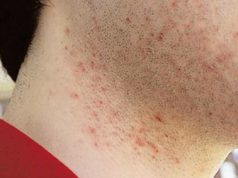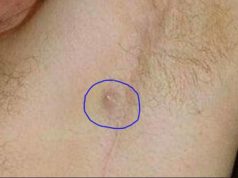Dealing with ingrown hair on the balls sack is one of the toughest tasks men swear by. Here are the causes of the backward growing hair and how you can go about getting rid or treating them.
Causes & Symptoms
Ingrown hair in this area is common in particular people perhaps due to their dressing, level of hygiene, poor hair removal technique and aftershave care, genetic predisposition, and those with curly hair.
Anatomically speaking, this part of the reproductive system is a fibromuscular cutaneous sac that is located between the male reproductive organ and the opening at the end of the alimentary canal through which solid waste matter leaves the body.
Causes
So far, poor shaving techniques is the mainstay cause of ingrown hairs. There are however other factors. Here they are in detail:
- With regard to poor shaving technique, preference is made on the direction of shaving, the quality of the tools used, closeness of the shave and aftershave treatment. Most people tend to shave too close to the skin. This has profound effects as it results in complete chopping of the follicle. It may be embedded under the skin owing to its short stature and especially on accumulation of dead skin cells. Shaving too close may also result in cuts and wounds in which hair follicles could find themselves curved into. Using blunt blades or razors forces one to redo the same area over again. This pushes some residues into the pores causing them to block them. Redoing them also compels you to shave against the grain which is entirely discouraged.
- Dry skin on the – Dryness makes the skin surface harder than that of a well moisturized skin. This disallows the penetration of a hair follicle over the surface. It is trapped below the surface and turns out to be ingrown. Dry skin is also prone to cracks and forming crevices which are a point of entry into the skin.
- Deposition of dead skin cells – dead skin cells are normal to have but if they build up in such a manner as to clog up the pores through which hair passes, they result in ingrown hairs. The layers continuously form on the dermis making penetration harder and hair curves back.
- Too oily a skin – oil is good for your skin but having it in excess can cause ingrown hairs. The oil leads to blockage of the hair pores through which follicles pass as they grow. When they meet this obstacle of oil clogging the pores, they are forced to grow inwards. At times this oil production is triggered by what you have in your diet. Lifestyle is also a contributing factor.
- Curly hair – if you have curly hair all over your body, you are at a higher risk of getting ingrown hairs. If you try shave this hair, it may curl back into the skin. This curling back may cause blockage of skin pores. It could also simply re-enter the skin and cause inflammation. Coarse hair could also be a cause since it tends to grow sideways while trying to exit the skin.
- Pili multigemini[1]– This is a malformation whereby there is a bifurcated or multiple divided hair matrices and papillae. This leads to multiple hair shafts within hair follicles. This might also lead to ingrown hair cysts.
Symptoms
The signs and symptoms of ingrown hairs in this area may be easily confused with STDs, boils or herpes and it is therefore important that you understand the symptoms of ingrown hairs for you to differentiate the three.
- Bumps – When an ingrown hair develops, you may not notice it as an ingrown hair but see bumps that are round and small. These are known as papules. They may however graduate into pustules when they are infected and become pus-filled. The bumps may be red if blood filled, white, yellow or green when pus-filled attaining each color depending on the extent of infection.
- The skin around the area of affected the follicle may attain a darker tinge typical of hyperpigmentation.
- Itching, pain, and tenderness around the area of the ingrown hair are common due to inflammation. This mostly occurs around the swollen sharp and stiff hair.
- A burning sensation that may be accompanied by a foul-smelling discharge from the ingrown hair bump.
- Irritation on the bumps which are hardened.
- Small painful fluid-filled blisters.
- Inflamed skin which is tender to touch
- If it is a cyst then it may bear a tiny blackhead at the center of the inflammation.

Folliculitis
Folliculitis is basically an abscess. It is an area on the skin which is infected around the hair follicle. It is pus-filled since it is an infection. When folliculitis occurs on the male organ, it might not point out to a cause by ingrown hair follicle.
This is just one of the many causes including trauma and injury to the area that led to an infection or a bite by an insect that led to the same. Therefore, folliculitis refers to the end result which is the abscess.
The link is that ingrown hairs are a leading factor to folliculitis and its complications including a furuncle (boil) therefore being referred to as an ingrown hair boil and carbuncles if they are clustered.
Folliculitis may result in ingrown hairs on surrounding parts of the skin due to a breach resulting from the inflammation. Other hair follicles may not properly penetrate the skin during this.
Further Reading:
How to get Rid
Removal and treatment of ingrown hairs can take the following steps:
- To rid the inflammation, condition-treating hormones preferably a 1% hydrocortisone and apply. Apply days before the procedure. If you see signs of infection, consult your doctor
- Use a warm compress method to soften the area. It could also help in draining the sac if any. Care should be taken when draining to prevent spreading the infection. A ball of cotton wool should be close to collect the fluid. Do this by heating up some water with a washcloth in it. Remove it once warm then place it on the affected area. Compress for a few seconds while letting it breathe. Do this three times.
- The warm compress should let you see the follicle if it was invisible under the skin.
- Clean the affected area, the whole of it in a circular manner from the center going outwards. You could do this using a mild antibacterial soap or cotton wool soaked in alcohol or a swab if available.
- Prep your tweezers and needle or pin by sterilizing them.
- To coax the ingrown hair out, use the pin to drain it if there is still some fluid left. Then use the tweezers to pull it.
- Make sure to not uproot the hair follicle.
- Do the after-treatment by including antibacterial ointment and some disinfectant in your aftercare cart.
Note that it would be important that if your bump has signs of an infection such as a fluid-filled sac, you should seek medical attention so that it can be safely and professionally drained and treated.
To alleviate the pain and treat the infection, there are a variety of medications that could be applied or taken orally. This and including other treatment options are enlisted below:
- Hydrocortisone cream 1% – reduces the inflammation and improves wound healing. Apply twice a day and as recommended as withdrawal from the medication should be a gradual process with reducing the doses in a tapering fashion. Consult your pharmacist.
- Use salicylic acid or benzoyl peroxide to exfoliate and remove dead skin cells.
- Retinoids – administered to reduce hyperpigmentation and remove dead skin cells that occur with ingrown hairs. It also promotes replacement of dead skin cells.
- Your prescription will have antibiotics if you have an infection. Do not take antibiotics without a prescription and on this medication, ensure that you complete the full dose. They will only be prescribed when the skin is severely infected.
Other methods of treatment include stopping shaving and waxing for a particular time as they are common causes of ingrown hairs and removal of dead skin through exfoliation (sugar or salt scrub)
Tips to Prevent
While avoiding the idea of shaving could be the best prevention measure, here are some tips to preventing ingrown hairs from occurring.
- Always shave along the grain.
- Make sure that you use a single-bladed razor and clean it after every stroke.
- Avoid shaving too close to the skin as this could cause more ingrown hairs.
- Apply shaving gel after you have finished shaving. You could too, apply a moisturizer on your skin to prevent drying.
- Wet your skin before shaving.
- Avoid wearing undergarments. Wear something that allows proper air circulation and exerts minimal pressure on hair follicles
Sources
[1] Naysmith, L., De Berker, D. and Munro, C.S. (2001), Multigeminate beard hairs and folliculitis. British Journal of Dermatology, 144: 427–428. doi: 10.1046/j.1365-2133.2001.04047.x




What helps me with post-shaving itchiness and discomfort is ToppCock Silver hygiene gel. It has aloe vera and natural anti bacterial and antifungal ingredients that do not only relieve discomfort but also prevent any razor burns and ingrown hairs from getting infected.
If you don’t want ingrown hair, then use another method than shaving. I fixed my ingrown problems by having my pubic hair permanently removed. My wife absolutely loves it. No stubble, no infections, and no pubic hair ever again.
That sounds lovely, hairless. What method did you use and at what cost in time and money?
I’m waging a freakish war on pili multigemini at the mo while something else is robbing the hair on my head! Very weird but may be due to some kind of immune response from a misfiring nervous system. The doc will be sure to have fun with this one! Starting at one end and finishing at the other 😉